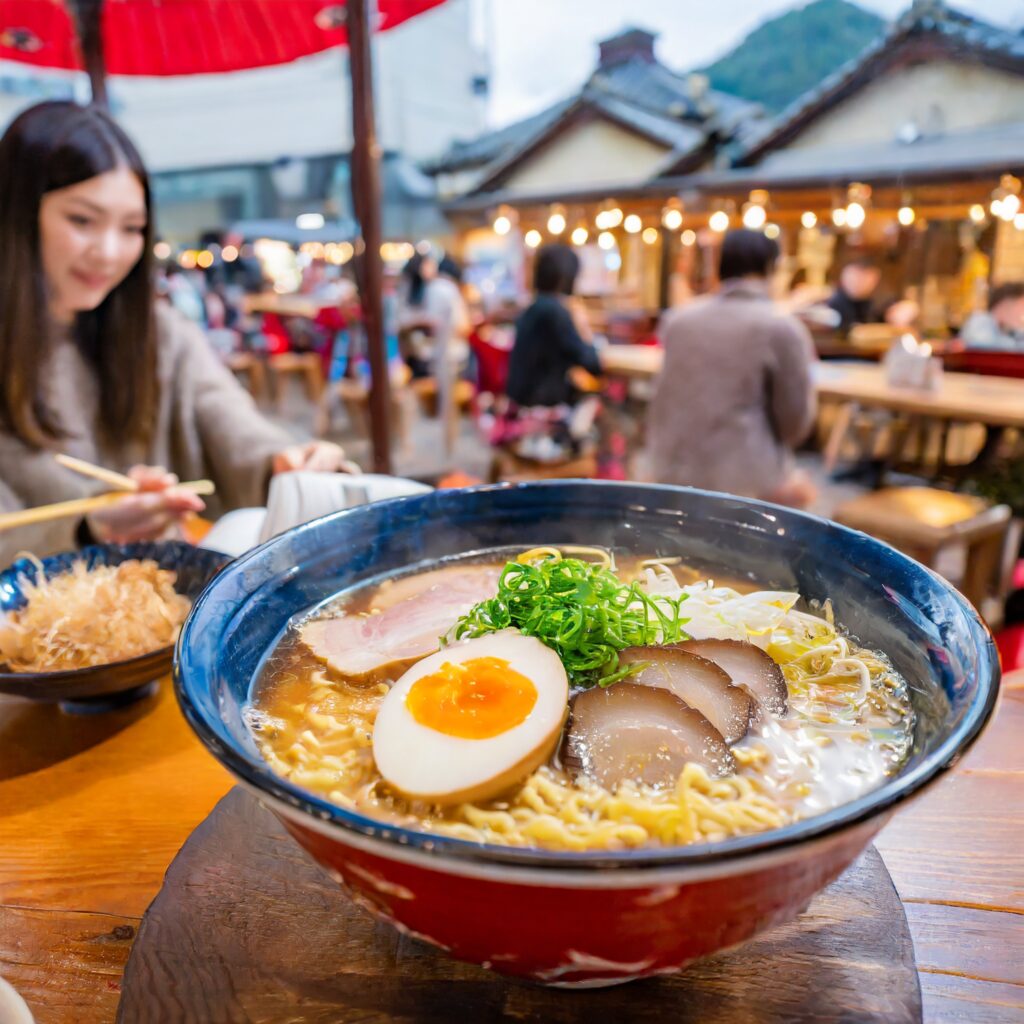

Introduction of a Ramen Enthusiast
The magic of ramen has continued to captivate my heart for several decades. As a ramen enthusiast, I carry a passion deep within me dedicated to this incredible dish. Ramen, with its deliciousness, diversity, and historical significance, stands as a cornerstone of Japanese culinary culture. Among them all, it’s pork bone ramen that has particularly entranced my heart.
Excitement About the Allure of Pork Bone Ramen
Pork bone ramen is a blissful bowl created through the slow simmering of pork bone marrow, resulting in a rich, deep broth, chewy noodles, and aromatic toppings coming together in perfect harmony. Within this single bowl of ramen, you’ll find a treasure trove of Japan’s culinary culture, history, and regional distinctions waiting to be explored.
In this article, drawing from over 20 years of experience as a ramen enthusiast, we embark on a quest to uncover the history, features, and allure of pork bone ramen. As we delve into the enchanting world of pork bone ramen, we are well-prepared to embark on this journey together with you. Let’s set out on this adventure.
The Origin and History of Pork Bone Ramen
Origin and Introduction of Ramen to Japan
Ramen has its roots in China, evolving from Chinese noodle dishes. The first introduction of ramen to Japan occurred towards the end of the Edo period when the country opened its doors to foreign influences. Among the various ramen types, pork bone ramen is particularly renowned, with its origins traced back to a street vendor known as “Nankin Senryo” in Kurume, Fukuoka Prefecture, during the Showa 12th year.
The Birth of Pork Bone Ramen
Pork bone ramen is characterized by its rich umami flavor and unique aroma, achieved through the long, slow simmering of pork bone marrow. It’s an irresistible delight.
Post-War Development and Refinement: After World War II, ramen rapidly gained popularity within Japan, leading to the development of regional styles across the country. Particularly, pork bone ramen took root as a significant part of Kyushu’s culinary culture, resulting in distinctive regional styles such as Hakata ramen in Fukuoka, Kumamoto ramen known for its charred green onions and garlic, and Kagoshima ramen with its soy sauce-based broth. These regional variations showcased unique developments that made pork bone ramen truly special in each locale.
Pork bone ramen, with its diversity and uniqueness, stands as a significant cornerstone in Japanese ramen culture. The distinctiveness of its soup and flavor continues to captivate numerous connoisseurs and ramen enthusiasts, and its allure only continues to expand even today.
Characteristics of Pork Bone Ramen
Pork bone ramen has captured the hearts of many ramen enthusiasts through its rich and flavorful soup, noodles, toppings, and condiments.
Soup: Profound Depth of Pork Bone Base
The most distinctive feature of pork bone ramen is the richness and depth of its soup. This soup is primarily crafted through the lengthy simmering of pork bone marrow. Pork bone soup is creamy, packed with deep umami, and can occasionally be perceived as indulgently fatty. It warms the body on cold days and fills the heart, with just one sip enough to experience the allure of pork bone ramen.
Noodles: Thick vs. Thin, Firm vs. Chewy
Pork bone ramen offers a range of noodle variations. Thick noodles interact well with the soup, offering satisfying chewiness. Thin noodles allow you to savor the soup’s flavor more distinctly and enjoy the harmony with it. Moreover, there’s a choice in noodle firmness, with “kata” (firm) and “koshi” (chewy) being common orders, and there’s also “barikata,” a unique option in the world of pork bone ramen. Discovering your preferred type of noodle is a delightful journey.
Ingredients: Chashu, Menma, Ajitama, and More
Pork bone ramen boasts specific ingredients that are essential. Common toppings include chashu (thinly sliced pork), menma (pickled bamboo shoots), ajitama (soft-boiled eggs), negi (green onions), nori (seaweed), kikurage (wood ear mushrooms), and more. These ingredients enhance the compatibility between the soup and noodles, elevating the deep flavors of pork bone ramen.
Condiments: Garlic, Black Vinegar, Spice, and More
To suit individual preferences, an array of condiments can be added. Garlic, available in both fried and minced forms, enhances the aroma. Black vinegar introduces acidity to the soup. For those who enjoy spiciness, there are options like shichimi togarashi (seven-spice blend) and karashi mustard. Pickled takana (mustard greens) is also a popular topping. These condiments serve as a way to customize your ramen to your liking, adding to the many enjoyable facets of the charm of pork bone ramen.
The diversity and individuality of pork bone ramen’s characteristics only serve to accentuate its allure.
Authentic Hakata Ramen
The Kyushu region, and especially Hakata City, is renowned for its Hakata ramen. Hakata ramen is known for its distinct features, including pork bone soup, Hakata-style thick noodles, generous use of pork fat, and unique toppings and seasonings.
Hakata-style Thick Noodles
Hakata ramen is characterized by its thick, flat noodles that interact well with the soup and offer a satisfying chewiness.
Hakata Tonkotsu Soup
The soup in Hakata ramen is prepared by simmering pork bones for an extended period, resulting in a rich and creamy consistency. It is common to add condiments like garlic and spice to this soup.
Toppings
Hakata ramen typically includes toppings such as chashu (thinly sliced pork), menma (pickled bamboo shoots), negi (green onions), and ajitama (soft-boiled eggs). The unique topping in Hakata ramen, “Hakata negi,” is especially rich in flavor and a must-have.
Pork bone ramen is a food where you can enjoy the distinctive characteristics of each region, and exploring the ramen culture of different areas can be seen as part of a delightful culinary adventure. Next, let’s focus on some famous pork bone ramen shops to discover their charms.
Popular Ramen Chains
Ichiran(一蘭)
Ichiran, known as a representative of Hakata ramen, is famous for its rich tonkotsu (pork bone) soup and chewy thin noodles. This popular chain allows customers to customize their order by writing their preferences on a paper order sheet. Ichiran is also renowned for its unique dining style, including the patented “flavor concentration counter.” If you have the chance to visit one of their establishments, be sure to savor their rich soup – you might even encounter a surprise.
Ippudo(一風堂)
Ippudo is a ramen chain known for its rich soup and unique kotteri (rich) style. Ippudo’s ramen, particularly its original “Shiromaru” and innovative “Akamaru” variations, has garnered support, especially from young people and ramen enthusiasts, and it has expanded to many cities. Preferences may vary between the classic “Shiromaru” and the bold “Akamaru,” but both are exceptional bowls of ramen that can only be enjoyed at Ippudo.
Hakata Tenjin(博多天神)
This popular shop with eye-catching yellow signs is mainly located in Tokyo. It serves a thick pork bone soup and firm, thin noodles, making it a must-try for those seeking “THE Hakata ramen.” The toppings include green onions, wood ear mushrooms, and chashu, following the classic yet simple combination. Once you try it, you might become addicted.
These renowned ramen shops stand out in terms of style and flavor, earning immense popularity among ramen enthusiasts. However, due to their popularity, these establishments often get crowded (typically, reservations cannot be made at ramen shops). When planning a visit, it’s advisable to check the crowd situation on platforms like Google Maps and schedule enough time for potential waiting. Each of these shops has dedicated years of research to provide unique flavors that have captured the hearts of fans, ensuring that you’ll enjoy a memorable bowl of ramen.
Introduction to Instant Ramen
Instant ramen is a convenient and popular way to enjoy pork bone ramen easily. Below, we’ll delve into the appeal and varieties of instant ramen.
The Appeal of Instant Ramen
Convenience: Instant ramen is easy to prepare, making it possible to enjoy authentic ramen even on busy days.
Variety
Instant versions of pork bone ramen come in various styles and flavors. You can choose from rich, light, spicy, and more to suit your taste.
Long Shelf Life
Instant ramen has a long shelf life, allowing you to stock it as a pantry staple.
Affordability
The cost per serving is relatively low, making it a cost-effective way to enjoy authentic flavors.
Representative Instant Ramen Brands
Maruchan Butagumi Tokusen Tonkotsu Shoyu Ramen:
This instant ramen features a rich and hearty tonkotsu (pork bone) flavor with toppings included.
Nissin Ippai-chan Tonkotsu Ramen
A simple and affordable option, this ramen combines a tonkotsu broth with medium-thick noodles, a well-liked combination.
Sapporo Ichiban Tonkotsu Ramen
Known for its light tonkotsu broth, this ramen offers variations with ample vegetables.
Nissin Chicken Ramen Tonkotsu Flavor
This instant ramen combines the base of chicken ramen with a tonkotsu-inspired flavor, offering a unique taste.
Instant ramen is beloved by many ramen enthusiasts for its ease and the ability to savor the authentic taste of pork bone ramen effortlessly. We recommend finding varieties that suit your preferences and giving them a try.
Rediscovering the Allure of Tonkotsu Ramen
Tonkotsu ramen has continued to captivate many with its rich flavors, heartwarming broth, and chewy noodles. In this chapter, let’s rediscover the allure of tonkotsu ramen and explore why it has ensnared the hearts of numerous ramen enthusiasts.
The Allure of Rich Broth
One of the most distinctive elements of tonkotsu ramen is its rich broth. Simmering pork bones for an extended period imparts depth and richness to the soup, allowing the savory essence of the pork fat to permeate throughout. The soup is a fusion of various seasonings and secret spices, creating its unique flavor profile.
Chewy Noodles
The noodles in tonkotsu ramen are also an enchanting component. Whether thick or thin, firm or tender (kata-me or koshi), these noodles contribute to the overall texture of the ramen. The chewy texture is beloved by many and serves to complement the flavors of the broth.
Diverse Array of Toppings
Tonkotsu ramen not only boasts flavorful broth and noodles but also offers a diverse range of toppings. Chashu (sliced pork), menma (bamboo shoots), ajitama (flavored soft-boiled egg), negi (green onions), nori (seaweed), and other toppings add depth and a variety of textures to the ramen. Each restaurant and region has its unique combinations and characteristics, providing diners with new surprises and satisfaction.
Distinct Regional Flavors
Throughout Japan, tonkotsu ramen exhibits unique regional variations. Regions such as Kyushu, Kansai, Tokyo, and Hokkaido have their own styles and flavors, each rooted in local traditions. Exploring regional ramen styles is an enticing prospect for ramen enthusiasts, as each area offers a distinct and delightful experience.
Related Information
Ramen Museum Official Website (https://www.raumen.co.jp/)
The official website of a museum that provides information about the history and culture of ramen.








